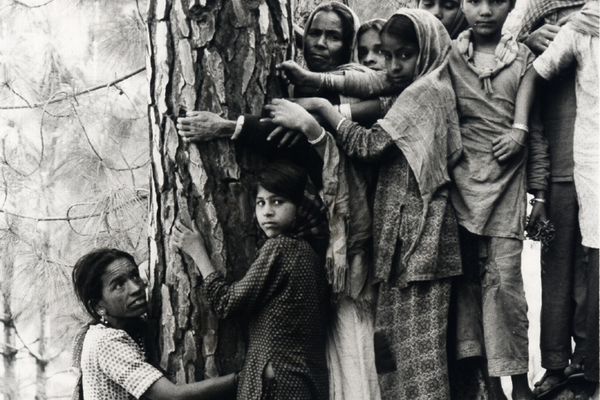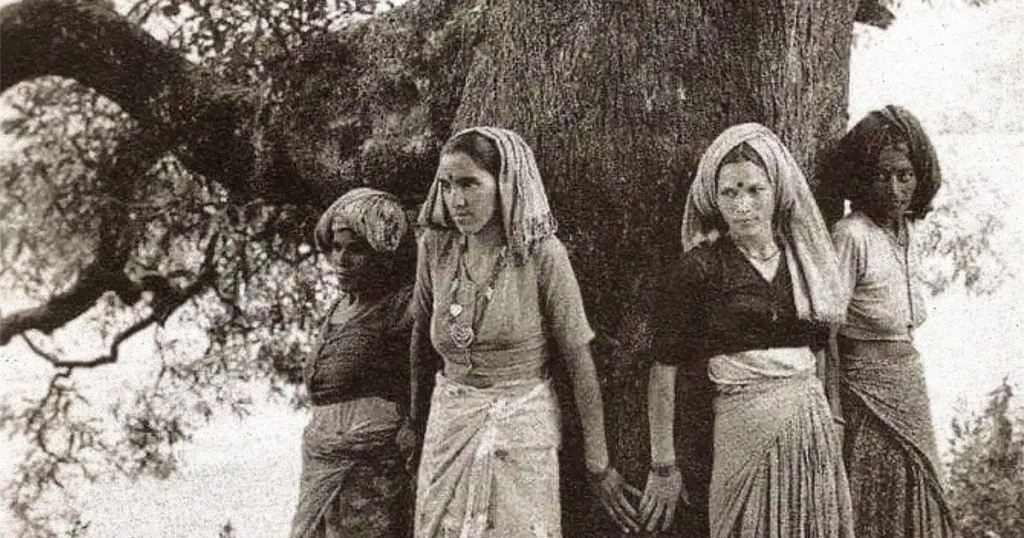Chipko Movement, also known as Chipko Andolan, celebrated its 50th anniversary as a non-violent social and ecological movement in India.
About Chipko Movement
- The Chipko movement, also known as Chipko Andolan, is a non-violent social and ecological movement in India that began in the 1970s to protect trees from commercial logging and government-backed policies on deforestation.
- It is one of the earliest examples of a collective effort aimed at forest conservation, revolving around the practice of hugging trees to prevent them from being cut down.
- It is also renowned for mobilizing women for forest preservation and is recognized as an eco-feminist movement.
- This movement led to a shift in attitudes regarding women’s status in society.
Origins:
- The Chipko Movement originated in the Himalayan regions of Uttarakhand (then part of Uttar Pradesh), in 1973.
- The name of the movement ‘chipko’ comes from the word ’embrace’, as the villagers hugged the trees and encirled them to prevent being hacked.
- The movement, led by Sunderlal Bahuguna in the Garhwal forests, ended in 1974.
- Leaders like Gaura Devi, Amrita Devi Bishnoi, Medha Patkar, A. K. Banerjee, and others strengthened it.
- The movement drew inspiration from the original Chipko Andolan initiated by Rajasthan’s Bishnoi community in the 18th century.
Women’s role in the movement:
- The Chipko movement can be described as a women’s movement.
- Women formed the nucleus of the movement, as the group most directly affected by the lack of firewood and drinking water caused by deforestation.
- The movement saw poor, rural women embracing trees to halt deforestation.
- They became the backbone of the movement and took on significant roles in afforestation efforts.
Challenging societal norms:
- Women’s involvement in the movement challenged traditional gender roles and empowered them to assert their rights and interests.
- The movement evolved into a dual purpose of conservation and challenging societal norms.
- Women aimed to protect the environment while also challenging the status quo, which favored men, demanding a voice in decisions that impacted them.
About Eco-feminism:
- Ecofeminism is a social and political movement that blends elements of feminism and environmentalism.
- It explores the relationships between women and nature.
- It explores the intersections of gender oppression and environmental degradation, arguing that both are rooted in similar systems of domination, exploitation, and hierarchy.
- Ecofeminists believe that patriarchy and capitalism are the causes of both women’s oppression and the degradation of the environment, and that any strategy to address one must also consider the impact on the other.
Factors that led to emergence of Eco-feminism:
- Interconnectedness of exploitation: Ecofeminism links women’s rights and environmental concerns, promoting both simultaneously.
- Women, disproportionately affected by poverty, bear the brunt of agricultural challenges due to climate change, like food shortages.
- Women’s lived experiences: Women, being solely in charge of cultivation, livestock and children, suffered the most due to floods and landslides, caused due to rise in deforestation in the face of urbanisation.
- Importance of traditional knowledge: Eco-feminism recognizes the significance of traditional knowledge, often held and transmitted by women, in promoting sustainable practices.
- Globalization and industrialization: It disproportionately affected women, prompting scrutiny of capitalist systems.
Relevance of Ecofeminism in present time:
- Ecofeminism is relevant in present time because it helps to analyze the profit-driven, sexist system of capitalist patriarchy that harms the ecosystem by exploiting natural resources and the people who live there.
- For example, research shows that climate change is not gender-neutral, and women are increasingly vulnerable to its impacts than men.
- Women are often the majority of the world’s poor and more dependent on local natural resources.
- Ecofeminism also explores the sustainable relationship between women and the environment.
Other Important eco-feminist movement in India:
- Narmada Bachao Andolan: It started in 1985 to oppose the construction of large dams on the Narmada River.
- Led by native tribes, farmers, environmentalists, and human rights activists, including Medha Patkar.
- The Appiko Movement (1980s): It was inspired by the Chipko movement, with women in Karnataka’s Western Ghats hugging trees to halt deforestation.
- The Silent Valley Movement (1973): It aimed to protect a rainforest in Kerala from being flooded for a hydroelectric project.
Ref:Source
| UPSC IAS Preparation Resources | |
| Current Affairs Analysis | Topperspedia |
| GS Shots | Simply Explained |
| Daily Flash Cards | Daily Quiz |



